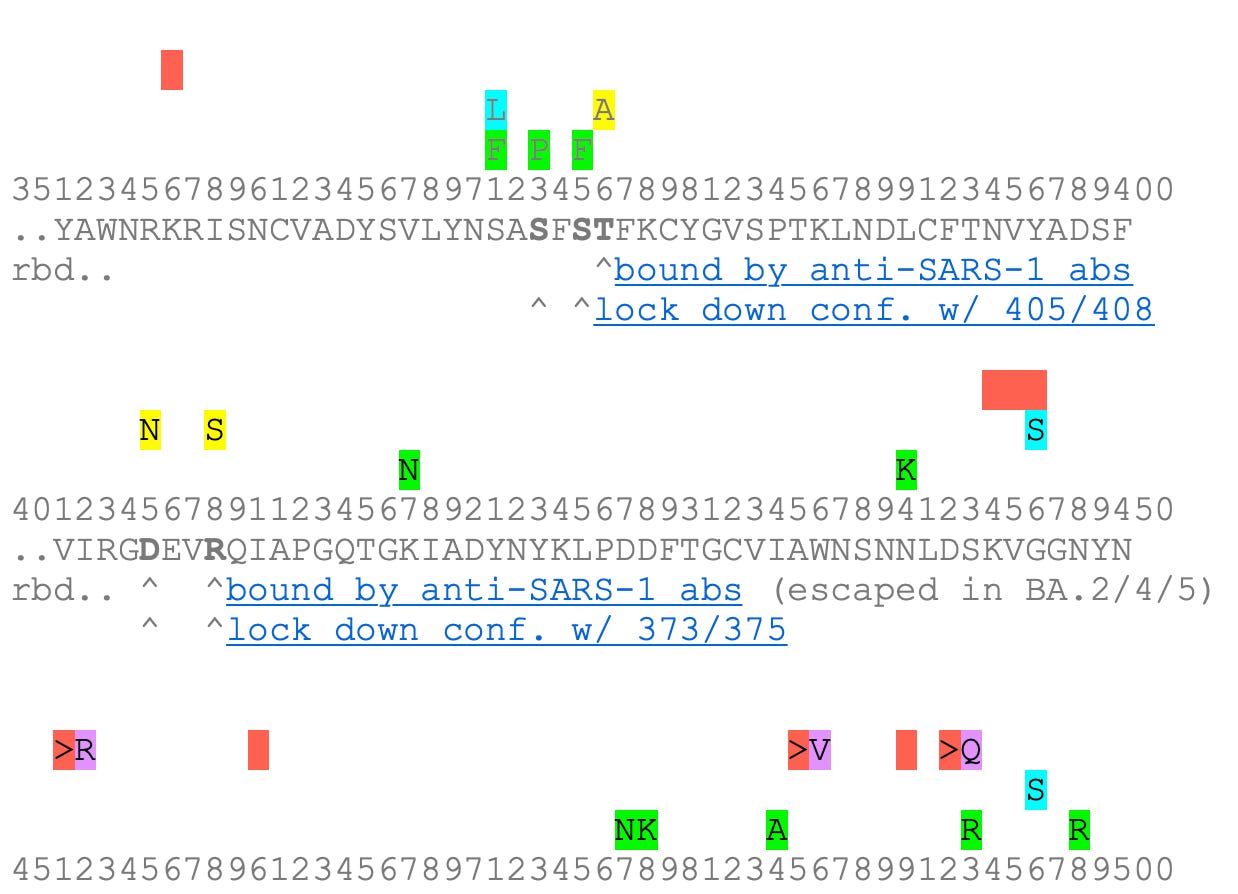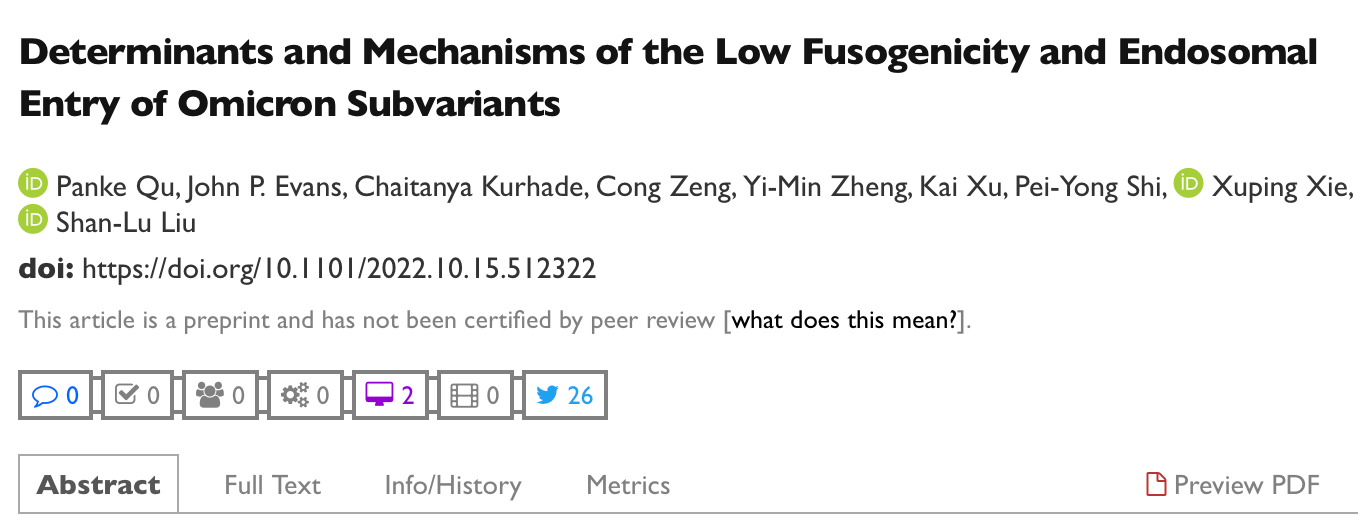New spike knowledge; resource upload (spike structure map)
Clarity on BA.2/5 fusion-iness and (possibly) East Asian immune escape.
Highlights:
Brian shares a clunky text-based map synthesizing spike protein links that he made!
H655Y, a universal Omicron mutation, impairs spike protein fusion! Early reports that BA.2 rescues fusogenicity were thus probably overblown.
Another study finds that BA.2 (and 4/5) may evade SARS-1 or generic sarbecovirus immunity! This could explain the elimination of the “dark matter” immunity that prevailed in east Asia before Omicron. Maybe. It’s interesting, anyway.
Another study finds that spike stabilization in the synthetic (mRNA or subunit) vaccines results in fewer post-fusion antibodies. For unclear reasons, this is assumed to be good!
Resource upload: Spike structure map
You don’t analyze genes in text format. It would be crazy to do so, because genes change, and eventually these changes will throw all your work in the garbage. So you get someone who took a computational genomics course to write a program that takes the sequence and plots the resulting values accordingly. This is the only way you keep yourself from wasting huge amounts of time and never amounting to anything in the world of science.
So anyway I made a text-based map of the SARS-CoV-2 spike protein, classic Wuhan recipe. It includes an abridged series of relevant links to papers describing function or structure of certain interesting parts, including controversial “inserts;” as well as a copy map with the Omicron mutations.
Given that all the work was done with copying and pasting text around like a crazy person, this resource comes with a use at your own risk warning. The example screen-grab shows the interesting BA.2/5 mutations that might explain why these variants finally drove high cases in East Asia, discussed below:
The all the Omicrons are Bad at Fusion Study!
The study:1
Context:
When “Omicron” debuted a year ago, multiple teams immediately went to work dissecting it to understand what made it different from previous versions of SARS-CoV-2. In particular: The Omicron (BA.1) spike was nearly fusion-defective, which also made it better at facilitating endosomal cell entry, explaining changes in tissue tropism, spready-ness, and pathogenicity; offering a strong clue for why it was more like a common cold.
But even before these results were published, it turned out not to be one virus but several, with the BA.2/4/5 family virtually as different from “it” (BA.1) as “it” was from classic models. And then “it” died out, and little to no confirmation that what was true for “it” is still true for the other Omicrons ever arrived. In fact, the earliest investigation of BA.2 spike suggested that it restored fusion,2 which threw into question whether a lasting change had occurred in the Pandemic™ or not.

Meanwhile, the mutation that is discussed below has previously been implicated in the change from fusion to endosomal entry; but no one had confirmed that BA.2/5 do not break that change (despite still having the mutation).
Results: The universal Omicron mutation, H655Y, impairs spike fusion
The authors find that BA.1 possesses two fusion-impairing mutations, and the other Omicrons only one; however, it is the universal mutation, H655Y, that truly alters the character of the spike. This quality is both lost when H655Y mutation is taken away from recombinant Omicron-spike-bearing viruses and gained when the mutation is given to recombinant Wuhan-spike-bearing viruses.

Notes:
Both these mutations are upstream of the Furin Cleavage Site, which is where the spike protein is chopped in half to allow the spring-loaded S2 “harpoon” to fire into whatever cell-membrane contains the ACE-2 that pulls at (binds) the lumpy S1 bits. While they do not prevent chopping (cleavage), they appear to stabilize the spike protein so that the harpoon still does not fire anyway. (This is similar in effect to the substitutions made to the protein for most of the synthetic vaccines; they don’t prevent cleavage, just fusion.)
Fusion allows the virus to spread from cell to cell without leaving the cell. It might make the virus more immune-evasive and pathogenic (Delta, for example, increased fusion, and apparently increased both those other two qualities in turn3); but at the same time fusion might slow the virus down, making it easier for children to fend off infection in the first place. So fusion could be what was impeding the virus, before the Omicrons, from infecting very many kids, or from transmitting outside of crowded indoor conditions!
Implications:
Because it was not clear if BA.2/5 still preferred endosomal entry, it has been hard to make conclusions regarding a sustained change between pre- and post-Omicron versions of the virus, namely regarding whether the fusionogenic versions of the virus favored crowded, indoor conditions. This has implications for whether those earlier viruses were actually capable of worldwide, sustained transmission without, you know, a little help from their “friends.” It is certainly clear that none of them spread with the energy and irresistability of the Omicrons. It now seems somewhat safe to attribute that change to the Omicron siblings’ move away from fusion.
The Other Interesting Spike Studies
BA.2/4/5 introduced mutations that escaped a cross-binding anti-SARS-1 antibody. This may explain why these variants finally escaped the “dark matter” immunity that previously pervaded in East Asia. (Obviously a lot more research would need to be done here, but it’s either that or pure wild guessing.)
Fusion-stabilized synthetic Covid vaccines lead to pre-fusion-focused antibody responses. Admittedly, this “clean,” pre-fusion antibody response was (allegedly) the “goal” of making it so that the spike proteins programmed by these injections could not successfully deform into the fusion state. (As opposed to, for example, the goal actually being to enable a lot of pro-pharma fact-checkers to erroneously claim that stabilization prevents the S1 subunit from breaking off and flying around the bloodstream even though it doesn’t do that at all.) At any rate, failure to develop post-fusion antibodies in advance of viral challenge may add one more explanation for vaccine failure, as those same antibodies plausibly would help immune cells take out infected cells that have already undergone fusion (via ADCC). (On the other hand, this narrowing of immune response wouldn’t be as important in the Omicron era since the Omicrons do not use fusion as much.)
If you derived value from this post, please drop a few coins in your fact-barista’s tip jar.
Qu, P. et al. “Determinants and Mechanisms of the Low Fusogenicity and Endosomal Entry of Omicron Subvariants.” biorxiv.org
Yamasoba, D. et al. “Virological characteristics of SARS-CoV-2 BA.2 variant.” biorxiv.org
Saito, A. et al. “Enhanced fusogenicity and pathogenicity of SARS-CoV-2 Delta P681R mutation.” Nature. 2022; 602(7896): 300–306.









So as mentioned in the SARS-COV1 study Sotrovimab was a monoclonal antibody that was isolated from someone previously infected with SARS-COV1. It was effective until Ba.2, likely from the T376A, D405N, and R408S group of mutations. These amino acids aren't on the surface, and so I believe it's assumed that these mutations led to a different folding pattern in the spike that shielded Sortrovimab's epitopes and stopped it from binding.
Brian - Seriously, God bless you. You are doing such incredibly important work, laying out the biochemical architecture of what is happening on earth in similar fashion to Katherine Watt revealing the legal architecture. I do not fully understand all your analysis. But I understand enough to see how true your aim is and how committed you are to both accuracy and precision. Please know you are deeply appreciated.